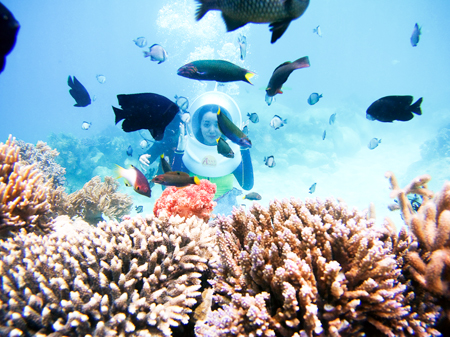
The study on establishing artificial reefs associated with reef restoration at Bang Thang Cape, Northwest of Hon Tre, Nha Trang Bay, conducted by M.A Nguyen Dinh Dan, Nha Trang Institute of Oceanography, since 2013 has just been approved...
The study on establishing artificial reefs associated with reef restoration at Bang Thang Cape, Northwest of Hon Tre, Nha Trang Bay, conducted by M.A Nguyen Dinh Dan, Nha Trang Institute of Oceanography, since 2013 has just been approved by Khanh Hoa Council of Science & Technology, contributing to coral reef regeneration, marine bio-diversity protection and diving tourism development.
 |
| Coral reef restoration helps promote tourist products on Nha Trang Bay. |
Bang Thang Cape is home to various types of coral. 53 types include 22 in Northern Hon Den and 39 Southern Hon Den. In recent years, overexploitation of marine resources and destructive fishing practices has led to coral reef degradation. Therefore, the study aims at reef restoration, landscaping for diving and minimize waves at beaches of Nha Trang Bay.
During the research, 100 conic concrete blocks have been built, covering 50,000 m2 of the seabed in Southern Mui Den, Bang Thang Cape to develop 4,000 m2 of coral reef. The 3,974 coral population has been developed for regeneration on concrete blocks and the natural sea bed. 3 kinds with a high survival rate, 69.9%, are likely to survive at Bang Thang Cape. The coral on concrete blocks has a higher survival rate than in the natural seabed. Hard and soft coral reefs available have also been maintained and restored, adding attraction to tourism and diving sites, contributing to biodiversity reservation.
Apart from coral restoration study, the researchers have evaluated impacts of artificial coral reef on minimizing waves at beaches of Nha Trang Bay in Northeast and Southwest monsoon seasons. Study has shown that the motive power and flow before and after the construction of artificial coral reefs has negligible impact, under 1%, on minimizing waves at beaches of Nha Trang Bay. The study has been found to basically meet required purposes, according to Khanh Hoa Council of Science & Technology. The application of the study in reality is expected to meet various targets for coastal marine resources protection and regeneration; environmental and marine biodiversity reservation, especially diving tourism development in coastal areas in Khanh Hoa.
According to Nguyen Dinh Dan, more time is needed to assess the effectiveness. Further research on coral regeneration is required to define suitable coral for the area. The initial study success needs to be expanded to other coastal areas with marine tourism and recreational potentials and resorts. The researchers have suggested local authorities and potential businesses apply study results in other places for marine tourism development in the future. Strict coastal management and planning are required to effectively develop the model.
Luu Khanh
Translated by N.T










